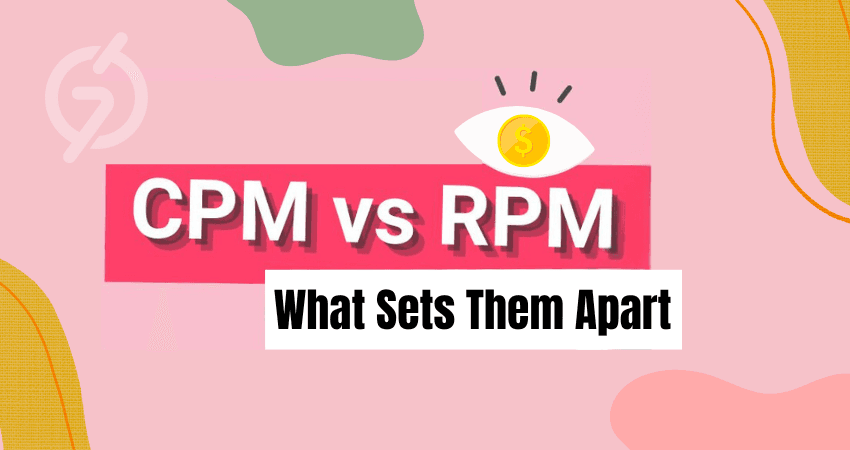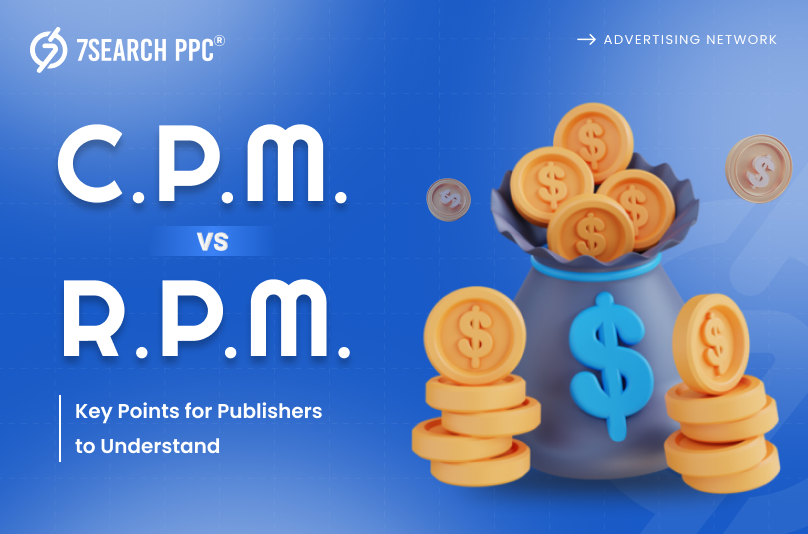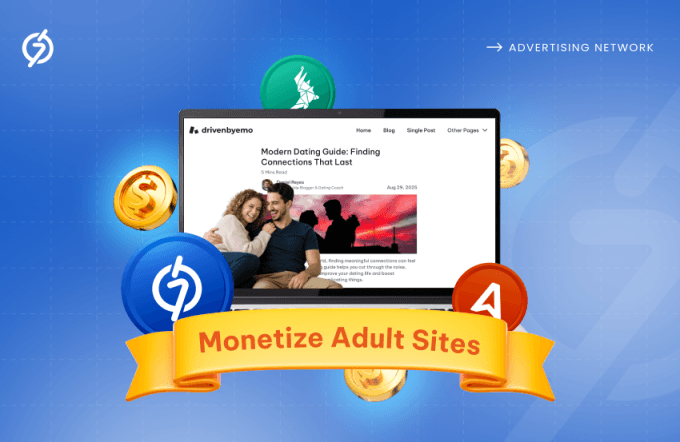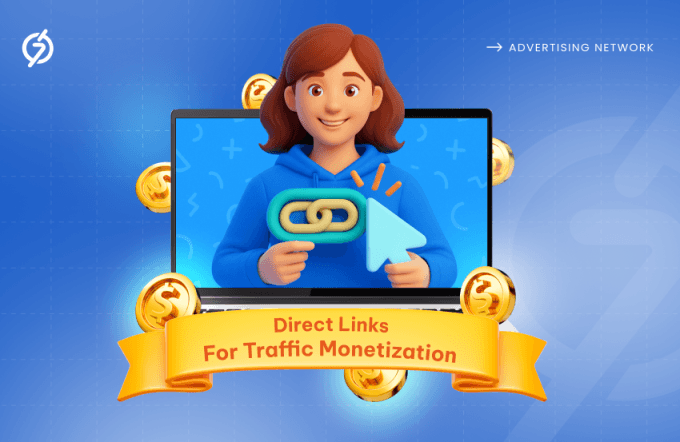CPM and RPM are two metrics that sound the same, but they are different from each other. New publishers mostly get confused by these two terms, so they treat both as the same. CPM stands for Cost Per Mille, which is what advertisers pay for every 1,000 times their ad appears. RPM, or Revenue Per Mille, measures the revenue generated from every 1,000 ad impressions. Today, we will be focusing on CPM vs RPM, two key metrics that can significantly impact your earnings.
So why do publishers need to understand the key points of CPM and RPM? What is their nature, and how do they work? Everything we will cover in this blog. By the end of this blog post, you will feel confident in interpreting these terms and using them to improve your website monetization strategy.
So, readers, let’s walk toward the world of CPM vs RPM.
CPM vs RPM: Essential Metrics for Online Ad Performance
CPM and RPM are known as the important key metrics in online advertising performance. CPM measures the cost an advertiser pays per thousand impressions of their ad. It shows their investment efficiency in reaching audiences. RPM, on the other hand, calculates the revenue earned for every thousand impressions. It indicates how effectively they monetize their content. It’s important to understand the key points of CPM vs RPM.
CPM is used to manage advertising costs and ROI, and RPM is used to maximize revenue from ad placements. Balancing these metrics ensures a sustainable approach to digital advertising that benefits both advertisers and publishers.
What Does Cost Per Mille (CPM) Mean?
Cost per mile (CPM), also known as cost per thousand impressions, is a common metric in advertising. It represents the amount an advertiser pays (according to bid) for every one thousand times their ad is displayed. This display is counted as an “impression,” whether or not someone clicks on the ad.
CPM is beneficial for advertisers who want to build brand awareness or reach a broad audience. It’s a popular choice in programmatic advertising, where ad space is automatically bought and sold. Unlike CPC or CPA pricing models, CPM charges advertisers for ad visibility rather than specific actions like clicks or conversions.
This pricing method helps advertisers estimate ad campaign costs and allows publishers to set rates based on expected impressions. Advertisers use CPM data to refine targeting and ad content, aiming to enhance performance and lower impression costs over time.
Publishers have a different perspective. They focus on generating quality content that attracts traffic and then focus on maximizing CPM rates to increase revenue from their ad inventory.
Exploring Various CPM Models
You are now familiar with CPM (Cost Per Mille), an advertising model in which advertisers pay for every thousand impressions of their ad. However, many people are unaware that there are different types of CPM. Let’s take a closer look at several types:
1) Effective CPM (eCPM): The eCPM metric shows how much revenue you earn per 1,000 impressions. eCPM focuses on publishers, taking into account how many impressions are shown and the revenue earned from those impressions.
2) Viewable CPM (vCPM): This metric focuses on impressions that are actually seen by a user. Not all impression impressions count as “viewable” — for example, if an ad loads at the bottom of a page that a user never scrolls down to see, it wouldn’t be considered available.
vCPM helps you understand how much you are earning for impressions that are actually seen by users, leading to more accurate revenue estimates and improved monetization opportunities for publishers.
3) Revenue CPM (rCPM): This metric takes into account all ad requests, not just impressions that are filled, providing an overall revenue generated per 1,000 ad requests.
It’s crucial for publishers to comprehend various CPM metrics to gain insights into their ad performance and make data-driven decisions about optimizing their advertising strategy. Instead of just achieving a high overall CPM, it’s essential to focus on eCPM, vCPM, and rCPM to fine-tune their approach and maximize revenue while delivering the best content to their audience.
Calculate Your Cost per Mille (CPM): The Universal Formula
To calculate CPM (Cost Per Mille), follow these steps:
Step 1: Collect Data
The initial step involves calculating both the total ad spend on the advertising campaign and the total number of impressions generated by that campaign.
Step 2: Apply Formula
CPM is calculated by applying the formula given below:
Cost Per Mille = Total Ad Spend / Total Number of Impressions x 1000
Here is an example
Suppose your ad campaign cost $1,000 and generated $500,000 impressions. Put these values into the formula:
Cost Per Mille (CPM) = 1000 / 500,000 X 1000
CPM = 2
So, the CPM for this ad campaign is $2 per thousand impressions.
By utilizing CPM, advertisers can assess the comparative expenses of advertising on different platforms, ad networks, or formats, which assists in allocating budgets and optimizing campaign strategies.
Benefits of Using CPM for Publishers
CPM (Cost Per Mille), which translates to cost per thousand impressions, offers several advantages for publishers looking to monetize their content or platform. Here are some key benefits:
Predictable Revenue
CPM offers an income that publishers can easily predict. Publishers know exactly how much they’ll earn per thousand ad impressions. This allows publishers to do better budgeting and financial planning, especially if they have consistent website traffic. Unlike models relying on clicks or conversions, there is no pressure to get users to interact with the ads, making CPM a more relaxed way to monetize content.
Focus on Content Creation
CPM allows publishers to earn income regardless of user engagement with the ads. This frees them to concentrate on creating high-quality content that attracts and retains their audience. Instead of optimizing ads for clicks, the focus shifts to building a strong readership or user base, leading to a more natural and positive user experience.
Uncovers High-Value Advertisers
CPM campaigns aim to attract advertisers focused on building brand awareness and engaging a broad audience. By identifying advertisers who consistently achieve high CPM rates, publishers can find valuable partners. These advertisers likely target a relevant audience and are willing to pay more to reach them. Working with such advertisers can boost revenue and lead to long-term, mutually beneficial relationships.
Publishers Can Refine Their Ad Strategy Through Optimization
CPM encourages experimentation with ad formats. Publishers earn per impression, so they can test different ad formats, such as banner ads, video ads, or native ads, to determine which ones generate the highest CPM. Analyzing this data enables publishers to optimize their ad strategy for maximum revenue.
By understanding which formats resonate best with their audiences, publishers can create a more engaging user experience while simultaneously increasing their advertising income.
CPM is Good for New Publishers
CPM is a good option for new publishers because it does not depend on having a large existing audience or high engagement rates. This means that new publishers can easily start earning money from their content even before building a huge following. This can be beneficial for initial growth and for attracting advertisers who recognize the potential in a growing audience.
What Does Revenue Per Mille (RPM) Mean?
Revenue per mille (RPM) is an important metric that publishers use to measure their ad revenue performance. It shows the estimated earnings from ads for every 1,000 impressions or page views on a website. RPM includes revenue from different types of ads like display and video ads. For specific pages, there is a similar metric called page RPM that focuses on revenue per 1,000 page views.
This metric helps publishers identify pages that perform well and adjust their ad strategies accordingly. By analyzing RPM, publishers can evaluate the effectiveness of ad formats and placements, maximize the value of their ad inventory, and make strategic decisions across different ad exchanges.
RPM is, therefore, a crucial tool for increasing revenue and improving digital monetization strategies.
Calculating Revenue Per Mille (RPM): A Simple Formula
Revenue per mille (RPM) is a metric used in digital advertising to calculate the revenue earned for every thousand impressions served. Here is how you can calculate RPM:
1) Gather Data: First, you need to gather two key metrics.
- Total Revenue: This is the total amount of money earned from displaying ads.
- Total Impressions: This refers to the total number of ad impressions (or views) that were served.
2) Formula: You can use the following formula to calculate RPM:
RPM = Total Revenue / Total Impression x 1000
Here is an example:
Let’s say you are running online ads on your website, and you have the following data for a specific period:
Total revenue generated from ads: $500
Total impressions served: $200,000
Revenue per mille = 500 / 200,000 x 1000
RPM = 2.5
Therefore, the RPM for this example would be $2.5. This means you earn $2.5 for every thousand ad impressions served on your website during that specific time frame.
Benefits of Using RPM for Publishers
Using RPM (Revenue per Mille or Revenue per Thousand Impressions) offers several benefits for publishers. We have researched some benefits of RPM for you. Please take a moment and have a look:
Maximized Revenue Through Optimization
By monitoring RPM (Revenue Per Thousand Impressions), publishers can pinpoint the best ad types and spots that earn the highest revenue. This helps them structure their ad plan by focusing on what works best, boosting their earning to the fullest.
Informed Decisions Across Platforms
RPM allows publishers to evaluate the performance of their ad inventory across various ad networks and platforms. This comparison helps them determine which platforms offer the highest rate for their monetization efforts. It enables them to allocate resources and focus their efforts more effectively.
Enhances Audience Value
A high RPM indicates a valuable audience for advertisers. By monitoring RPM, publishers can gain insights into the demographics and interests of their audience. It allows them to tailor content to attract even more valuable viewers, further increasing their RPM.
It Allows For Experimentation for Optimal Results
Understanding their baseline RPM enables publishers to test various ad formats, pricing models, and audience targeting strategies. By tracking the effects of these changes on RPM, they can refine their approach and enhance their monetization efforts consistently.
It offers a Good Negotiation for Publishers
With a clear understanding of their RPM, publishers can use data in negotiations with advertisers. This enables them to secure a fair price for their ad space, ensuring they receive appropriate compensation for their audience’s value.
CPM vs RPM: What Sets Them Apart
CPM vs RPM are two fundamental metrics in digital advertising, each serving distinct purposes. Here is a detailed comparison of CPM vs RPM to understand what sets them apart:

1) Target:
- CPM: This is an advertiser-centric metric. It measures the cost an advertiser pays for one thousand ad impressions.
- RPM: This is a publisher-centric metric. It tracks the revenue earned by the publisher for every one thousand page views or impressions.
2) Tracking:
- CPM: It is useful for advertisers to track the cost of their ad campaigns. It helps them understand how much they are spending to reach a thousand viewers.
- RPM: It is useful for publishers to track the revenue generated from ads. It gives an overview of how much they are earning per thousand impressions or page views.
3) Ad Placement:
- CPM: It is mostly used to determine the price of ads based on their placement. Advertisers might pay more for ads placed in prominent positions.
- RPM: It focuses more on overall revenue generated by all ads across a website or app.
4) Bidding:
- CPM: It is used in ad auctions, such as those provided by ad networks, to determine the cost per impression of an ad.
- RPM: Not typically used in the bidding process. Instead, it reflects the revenue performance of the publisher’s ad inventory.
5) Modes/Types:
- CPM: CPM has three types: eCPM, rCPM, and vCPM.
- RPM: RPM has various types, such as Impression RPM, Ad RPM, Page RPM, and Ad-Request RPM.
Understanding CPM vs RPM allows advertisers and publishers to optimize their strategies better and accurately measure their performance in digital advertising.
Conclusion
CPM vs RPM are two important metrics in digital advertising. CPM is advertiser-centric, focusing on the cost per thousand ad impressions. It helps advertisers track campaign costs and optimize ad placement. RPM is publisher-centric, measuring the revenue earned per thousand impressions. It helps publishers assess ad performance and maximize revenue. By understanding CPM vs RPM, both advertisers and publishers can optimize their strategies and achieve their goals in online advertising.
Frequently Asked Questions (FAQs)
What is CPM vs RPM?
Ans. CPM vs RPM shows the distinctions between CPM and RPM. CPM means the cost an advertiser pays for every 1,000 times their ad is displayed. RPM is the revenue a publisher earns every 1,000 times an ad is displayed on their website or app.
Who cares about CPM vs RPM?
Ans. Advertisers and publishers care about CPM vs RPM because it helps them understand how much money they invest and make from online ads.
Are CPM vs RPM the same thing?
Ans. No. CPM vs RPM are different. CPM is the amount an advertiser pays, and RPM is the amount a publisher earns.
Which is better in CPM vs RPM?
Ans. There is no “better” metric in CPM vs RPM. CPM is good for advertisers who want to reach a broad audience, and RPM is good for publishers who wish to maximize their revenue.
Is there anything else I can do to learn more about CPM vs RPM?
Ans. Yes! There are many resources available online that can teach you more about CPM vs RPM.














![Proven Blog Traffic Tips To Grow Your Audience In 2025 [A Beginner-Friendly Guide] 5 Blog Traffic Tips](https://www.7searchppc.com/blog/wp-content/uploads/2025/10/Blog-Traffic-Tips-680x442.png)



